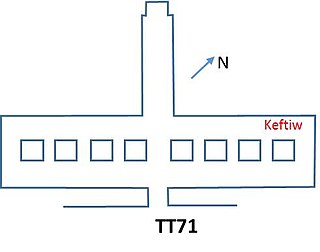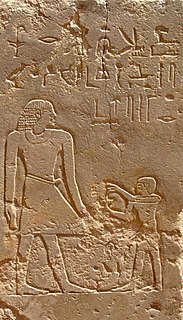
Deir el-Bahari or Dayr al-Bahri is a complex of mortuary temples and tombs located on the west bank of the Nile, opposite the city of Luxor, Egypt. This is a part of the Theban Necropolis.
Boyo Ockinga is an Egyptologist, epigrapher, and philologist of the ancient Egyptian language, who holds the position of Associate Professor in the Department of Ancient History at Macquarie University in Sydney, Australia.

Tomb TT188, located in the necropolis of El-Khokha in Thebes in Egypt, is the tomb of the Steward and King's Cupbearer Parennefer. It has been excavated by the Akhenaten Temple Project.

Theban Tomb TT71 is located in the Theban Necropolis, on the west bank of the Nile, opposite to Luxor. It was the tomb chapel of Senenmut, who was the steward and architect of Hatshepsut. The chapel is located in the necropolis area around Sheikh Abd el-Qurna. Previously the tomb was accessible and for most of this time the target of numerous investigations and intrusions, although early on already heavily destroyed. The tomb was visited already early. In the first half of the nineteenth century, John Gardner Wilkinson, Robert Hay and J. Wild copied scenes, although the decoration was already badly destroyed. Richard Lepsius (1842–45) took the false door to Berlin and copied some inscribed bricks. Only in 1906 Kurt Sethe copied all inscriptions. In 1930-31 Herbert Winlock cleared the whole tomb. Winlock found the fragments of a smashed sarcophagus.

Theban Tomb 69 is located in Sheikh Abd el-Qurna, part of the Theban Necropolis, on the west bank of the Nile, opposite Luxor. It is the burial place of the Ancient Egyptian official named Menna, whose titles included ‘Overseer of Fields of Amun’, and ‘Overseer of Fields of the Lord of the Two Lands’. Traditionally, TT 69 has been dated to the reign of Thutmosis IV. However, recent art historical studies of artistic style suggest the majority of the tomb was decorated during the reign of Amenhotep III.

The Ancient Egyptian Noble Paser was vizier, in the reigns of Seti I and Ramesses II, during the 19th dynasty. He would later also become High Priest of Amun.
The Theban Tomb TT31 is located in Sheikh Abd el-Qurna, part of the Theban Necropolis, on the west bank of the Nile, opposite to Luxor. It is the burial place of the Ancient Egyptian official, Khonsu who was First Prophet of Menkheperre, during the 19th Dynasty or 20th Dynasty.

Setau was the Viceroy of Kush in the second half of Ramesses II's reign. Contemporary records show that Setau served in this position from Year 38 until at least Year 63 of Ramesses II's reign. Setau was "a graduate of the royal school" and already enjoyed an impressive record of royal service which is detailed in a long autobiographical inscription carved at Wadi es-Sebua. The temple of Wadi es-Sebua was built for Ramesses II by Setau around 1236 BC or Year 44 of this pharaoh's reign. Eleven of his stela, now in the Cairo Museum, were found in the courtyard of this temple and make it possible to establish his career and understand the precise duties of a viceroy. Setau states:
Tyti was an ancient Egyptian queen of the 20th dynasty. A wife and sister of Ramesses III and possibly the mother of Ramesses IV.

Tomb TT189 is located in the necropolis of El-Assasif in Thebes in Egypt. It contains the sepulchre of Nakhtdjehuty, who was an overseer of the carpenters of the northern lake of the god Amun and the head of the goldworkers in the Estate of Amun during the 19th dynasty reign of Ramesses II. Nakhtdjehuty's tomb is part of the TT192 tomb complex.

The Theban Tomb TT212 is located in Deir el-Medina, part of the Theban Necropolis, on the west bank of the Nile, opposite to Luxor.

The Theban Tomb TT214 is located in Deir el-Medina, part of the Theban Necropolis, on the west bank of the Nile, opposite to Luxor.

Amarna Tomb 3 is a sepulchre near Amarna, Upper Egypt. It is dedicated to the Ancient Egyptian noble Ahmes (Ahmose). The burial place is located in the northern side of the wadi that splits the cluster of graves known collectively as the Northern tombs.
The Theban Tomb TT385 is located in Sheikh Abd el-Qurna, part of the Theban Necropolis, on the west bank of the Nile, opposite Luxor. It is the burial place of the Ancient Egyptian Hunefer (Haunefer) who was a Mayor of the Southern City (Thebes) during the reign of Ramesses II in the Nineteenth Dynasty.

Sabni was an Ancient Egyptian official of the Old Kingdom under king Pepy II. He was an expedition leader undertaking enterprises to Nubia. He is mainly known from his rock cut at Qubbet el-Hawa.
Theban Tomb TT382 is located in Qurnet Murai, part of the Theban Necropolis, on the west bank of the Nile, opposite to Luxor. It is the burial place of the Ancient Egyptian High Priest of Montu named Usermontu, who lived during the 19th dynasty and served under Ramesses II.
Paser was an Ancient Egyptian official under the king Ramses III in the 20th Dynasty. He was mayor of Thebes. His wife was a woman called Tity.
Mahu was an Ancient Egyptian official who was in office under king Ramses II. He is mainly known from his monumental tomb excavated at Saqqara.
Anhurmose was an Ancient Egyptian official of the New Kingdom. He was the high priest of Anhur under Merenptah, but started his career as a military man, most likely under king Ramesses II.
The Theban Tomb TT387 is located in El-Assasif, part of the Theban Necropolis, on the west bank of the Nile, opposite to Luxor.












